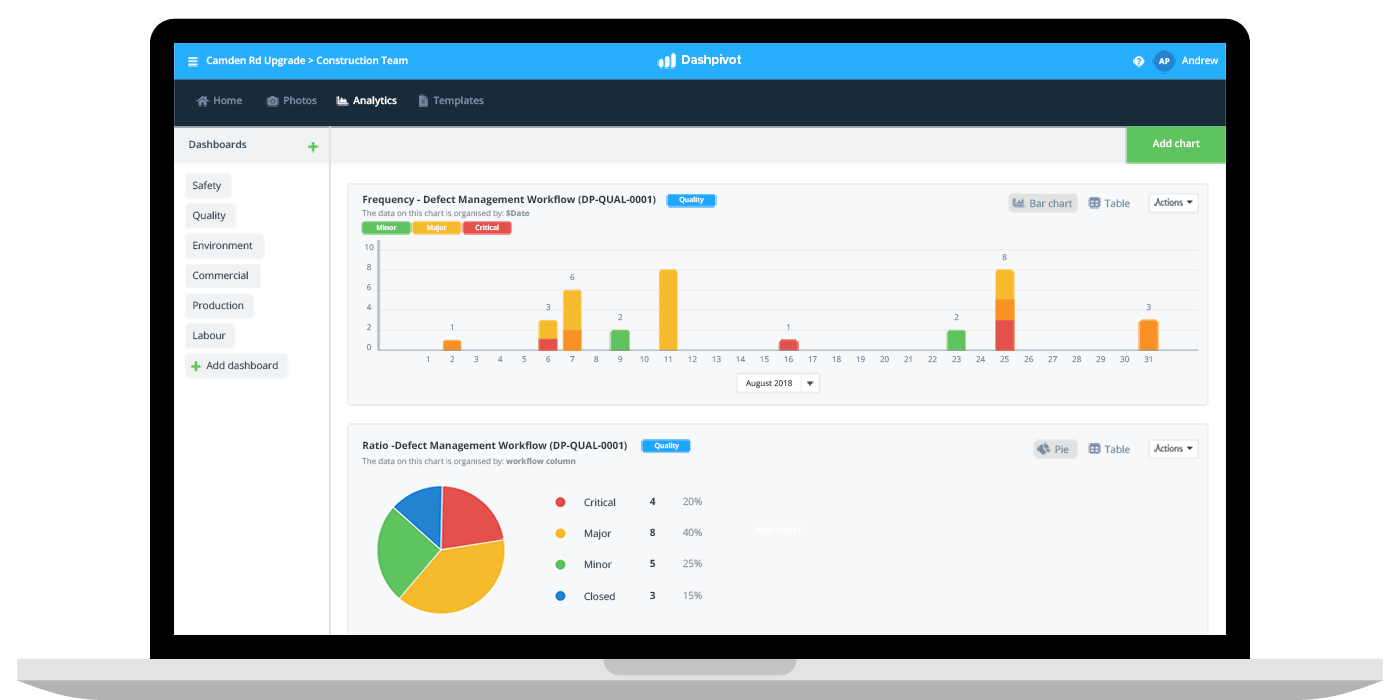Construction software – Construction project management software comparison

Construction project management software comparison
The right way to compare
Too many software comparisons pit one or two competitors up against each other as if the two solutions are inherently right for you. But the more helpful comparison is a market comparison in which you can find the solution which is right for the job you are trying to achieve.
At the end of the day, software is a means to an end for you. Software isn't your product or solution, its job is to simply enable you to do your job or jobs better.
This is why it's so important to understand the software landscape at a high level; no matter how good a piece of software is, it's only as good as the job it was designed to do. The features you are looking for are a 'product' of the problem it's employees and engineers are seeking to solve.
So what does a construction project management software market comparison look like?
The construction project management software landscape for comparison
Just like the construction industry itself, the market for construction project management software is fragmented. In the same way that every construction project requires tens or hundreds of specialist parties, the construction industry is big enough and complex enough to still require a number of software platforms which are each solving unique and hairy problems.
It's important to note and remember that a number of these companies do and will continue to call themselves construction project management software or construction management software, with varying nuance in their messaging and positioning. This makes it harder to fight through the noise, but also serves as a good reference point for you and these companies.
In the comparison below, we have compartmentalised the industry into digestible chunks which you will see align with a specific part of your business and operations.
We have outlined a vendor or two within each category so that you have a reference point for what a vendor in that 'category' or specialist area may look like.
At the end of the comparison, there is a 'bringing it all together' section which talks about how you can and should combine these different softwares and how the industry will naturally evolve in the years to come.
Project delivery - documents, forms and processes
The first part of the market to look at is the forms and daily processes part of the construction project management software market. This sector of the market is dedicated to creating efficient daily processes for your workers, both on site and in the office.
This sector of the market is the traditional software play, where manual processes and daily inefficiencies can be automated and streamlined through software.
A typically well served sector of the market, the biggest thing to keep your eye on here is how specialised (or flexible) you want your solution to be.
There are very specialised solutions like Site Diary which do one job, and that's to streamline (and usually digitise) your site diary.
From there, you have solutions focused on improving how you manage quality - so 'quality management softwares'. Within these 'bucket', there are individual solutions for many of your functions including geotechnical, production and finance.
And finally, there are broader softwares which aim to replace your entire internal management system. Within this area of the market, some solutions are extremely generic and have positioned themselves as being a solution for construction companies - like generic form builders and digital form softwares and products like Sharepoint.
Depending on where your inefficiencies are and how extensive your daily operations and manual processes are (how many forms do you fill out, photos you take etc.) will dictate what solution you choose here - but I'd say lean towards a flexible solution which is easily editable and customisable for your processes.
Many people have complained to us in the past that they have to 'fit' the solution rather than the solution fitting them. This is very typical of solutions which try to solve a problem like a site diary or total quality management. They are robust, but often rigid approaches to the problem and solution.
To give you a good analogy, Dashpivot provides you with the building blocks to get your jobs done. The architecture is laid out in such a way that you can build your processes into the software - but with the smarts and efficiencies of software. Finding the right project delivery solution depends on how you deliver your projects (and endeavour to deliver them).

Learn more about Sitemate's flexible project delivery software.
Project financials
Another meaty and often requested 'feature' of construction project management software is project financials. Financials are obviously extremely important when it comes to project management and they are also one of the areas which do require a lot of manual work and admin.
The financial controls and project financials part of the software market is also heavily populated. Many of the more 'general' financial and accounting softwares have proved very popular in construction and and the industries - companies like Xero, while there are also more catered and specific solutions like Progress Claim and Estimate One which seek to solve one area of project financials - such as claims or estimating.
Project financials can be a headache (and potentially dangerous) when managed poorly. It's incredibly important when shifting your financials and accounting to a software product that you know why you are doing it and how to use it. But most companies are and should be using software to manage their financials, because it saves so much time and makes reconciling and actioning financial information so much easier.
Site access and security
To give you a deeper understanding of the specialisation available in the construction management market, there is also solutions available specifically for site access and security.
While some of the form and processes solutions available solve this problem through quick and smart site induction processes, there is some sites and companies which have so much site action and a deep need for security and sophisticated inductions that they need a standalone solution.
Drawings management and design review
One of the most saturated segments of the market is drawings management and design review. And this is because many of the companies operating in this space were some of the first entrants into the construction management software space - and some of the first big companies to get traction.
Drawings management and design review solutions are some of the most requested and expected software solutions, as they improve high level and critical collaboration between clients.
The solutions in this area of the market have done a great job of improving collaboration and increasing transparency and accountability for clients, contractors and subcontractors.
Instead of emailing PDFs back and forth all day, companies can share, comment on and collaborate in real-time on drawings and designs. This saves time, and also creates a record of every change made. Similar to project delivery software, this software play has all of the obvious benefits of software including better communication and a more thorough and automatic record of everything going on.
Some of the major and well-know players in this space include Aconex and Autodesk. Both provide robust and proven solutions to the problem of drawings management and design review.
Survey, mapping & spatial
There are a number of other highly specialised areas of construction management which have taken individual companies and a lot of time and resources to solve.
One such area is survey, mapping and spatial. These jobs and tasks clearly benefit from new technologies such as extremely accurate geotargeting and geolocation as well as drone technology.
Companies making moves in this sector of the market include Propeller and Drone Deploy. These solutions are obviously more pertinent to some companies than others - and require specific projects and efforts to see enough value to warrant the price.
People, plant and labour
Another big and broad sector of the market is people, plant and labour. Managing these absolutely critical resources can be a massive time drain and cost companies a lot of money in dormant assets and poor resource management in general.
Because of this, and because of the interconnectedness of these assets and financial controls, these softwares have seen good traction and many companies are managing their people with more aplomb through software.
Once again, other areas of the market can help with this problem, including managing timesheets through project delivery software - but many companies at the moment still see enough value in managing some of their most important (and expensive resources) with dedicated software.
Bringing all of this software together under your 'one roof'
As you may have gathered, this isn't a completely comprehensive list. There are even more specialised solutions and the market is even more fragmented beyond these core categories.
Part of the issue with navigating this landscape in the way that you get what you want and need lies with successfully understanding the market and looking for the right solutions for you.
Markets typically fragment and consolidate in relatively typical waves. Because the construction software market is relatively nascent, many of the companies and startups entering this market and creating solutions are still finding unmet needs and creating new pockets and buckets within this greater construction management software landscape.
Once these 'holes' have been filled and each segment of the market becomes more and more saturated, there will be consolidation in the market.
Companies will come together and companies will create new products and solutions which bring them closer to fulfilling the promise of the full suite.
Until that happens, your technology 'stack' will involve more than one solution - which is becoming more common in all industries - and you can lean on integrations to help your softwares speak to each other and to get even more value and efficiency out of your solutions.
We have plenty of detailed information and explanations about the construction project management market (as that's where we live) so call us on 1-800-828-110 if you have any questions at all and we'd be happy to discuss the software landscape with you and help you find the best solution for what you are trying to achieve.